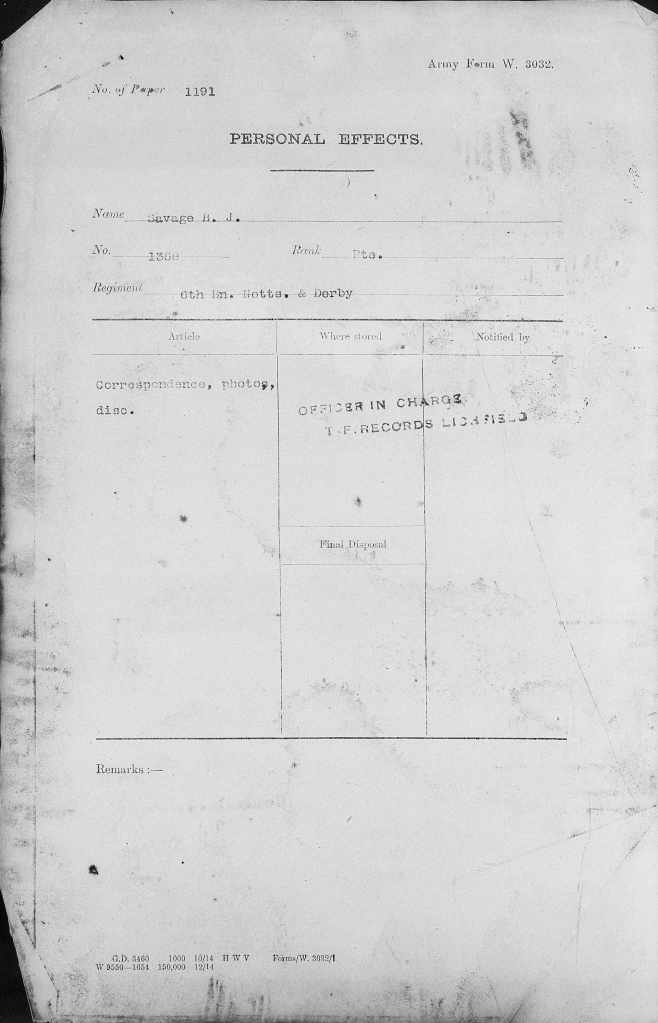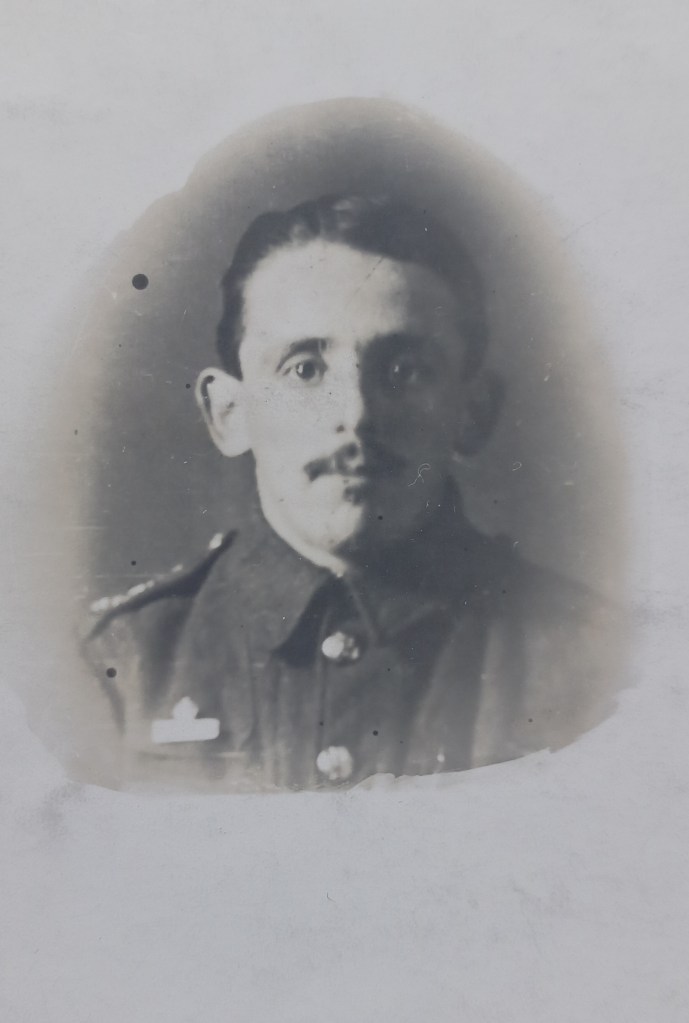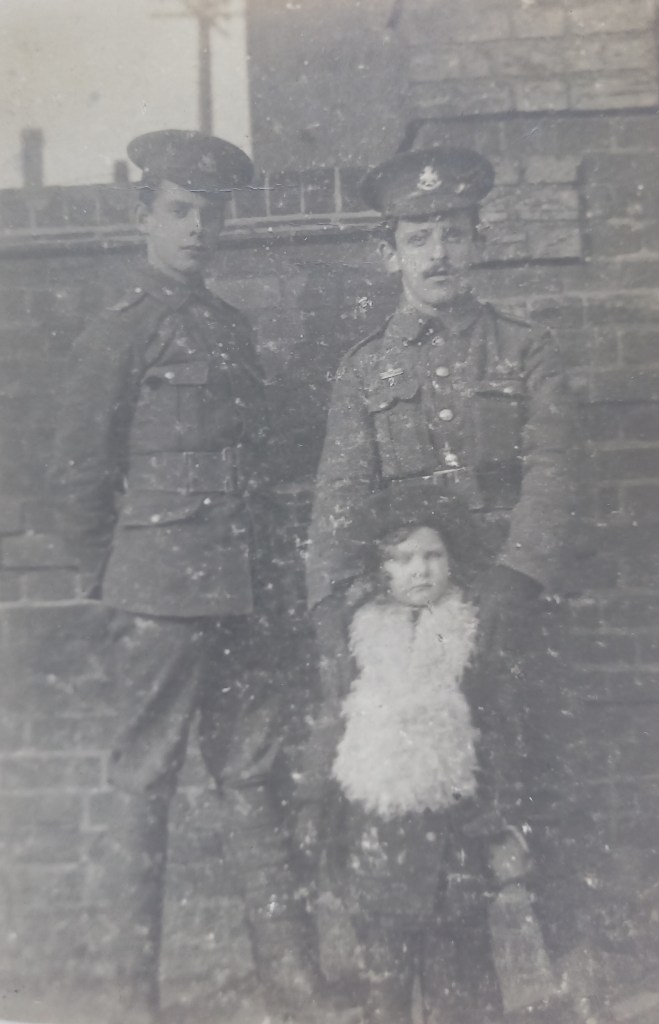A scarce original and complete pair



A mill hand from Cressbrook, who served with 5th Platoon “B” (Chapel & Whaley Bridge) Company and was killed during the attack on Hohenzollern Redoubt.
Many thanks to Marion Anderson for sending these pictures of her relative

Benjamin in his dress uniform. The backdrop indicates that this was taken at the 1911 summer camp held at Scarborough where he signed the Imperial Service Agreement – see here for details of the camp.
Benjamin enlisted into the 6th (Derbyshire) Battalion, the Sherwood Foresters (Notts & Derby) Regiment on 18th March 1911 aged 18 years. In the 1911 Census he is recored as a mill hand at Cressbrook Mill.
The first page of Benjamin’s army service record, which recorded him as just over 5′ 3″ tall and with good physical development. Benjamin attested and was medically examined at Tideswall, which suggests that he may have initially served with “D” Company that comprised men from Bakewell, Tideswall and Stoney Middleton.
Benjamin attended the summer camps of 1911, 1912 and 1913; interestingly, there is no record of him being at the Hunmanby camp of 1914 when war was declared.
Benjamin was mobilised with the other men of the 6th Battalion on the 4th August 1914 and would have arrived in Chesterfield the following day. See here for details of the mobilisation.
This picture possibly shows Benjamin’s section with the family that they billeted with in Harpenden. Benjamin is lying on the corner of the flag. Clearly visible are Imperial Service Badges above the men’s right tunic pocket. The men also have 5-tier Territorial shoulder badges and are equipped with ‘Long’ Lee Enfield rifles.
The 46th North Midland Division arrived in France in February 1915 and soon found themselves in front line trenches. The North Midland Division had trench duties at Ploegsteert Wood (March), Neuf Berquin (March), Kemmel (April to June) and Ypres (June to September) before taking part in the Battle of Loos and the attack on Hohenzollern Redoubt.
During a period of rest at Ypres the Battalion were able to organise an inter Company cricket match between platoons of “B” Company and involving many local sportsman from the Chapel and Whaley Bridge areas. Of the 22 men who played in the cricket game on that warm July afternoon, ten were to lose their lives before the end of the War, three of these before the end of 1915; one of those would be Benjamin.
During the fighting for Hohenzollern Redoubt the 46th Division suffered 180 Officers and 3583 men killed, wounded or missing. The 1/6th Sherwood Foresters had 13 men killed, one man missing believed killed and 2/Lts Percival and Gardiner and 48 men wounded. The bodies of all of the men who were killed were not recovered or their graves identified after the War and they are commemorated on the Loos Memorial. The fact that so many bodies were not recovered is a testimony to the severity of the fighting and only Bernard White from Grassmoor, who died in a casualty clearing station in the Chateau at Vermelles, has a known grave.
‘Casualty Form – Active Service’ recording that Benjamin had earlier suffered from acute urticaria (a chronic rash), most likely contracted from trench duty, and received treatment at the 1st North Midland Field Ambulance and then the 46th Divisional Clearing Station. The form also records Benjamin’s death ‘in the field’ on the 14th October 1915; he was only 22 years old.


Personal effects sent to Benjamin’s parent and subsequent correspondence from them enquiring about some missing items including a watch and leather wallet. It was likely that he had those items on his person and they were not recovered along with his body.


Benjamins’s family was presented with a ‘Next of Kin’ Memorial Scroll, Plaque and King’s Message. These were posted out separately, typically in 1919 and 1920, and a ‘King’s message’ was enclosed with both, containing a facsimile signature of the King.


Benjamin’s name is recored on the Cressbrook Village Memorial. The image on the left is the original wood Cenotaph that was erected before the permanent stone memorial (right). Amongst the other men listed is 19-year old Fred Ponsonby, who also served with the 1/6th Battalion, and was shot by a sniper on the 21st May 1915.


Benjamin’s father and mother, Thomas Hamilton Savage and Diana Richard-Savage who are standing on the doorstep of their home at Whitefield Road in Stockton Heath. Benjamin’s sister Isabel Savage-Charlesworth (right). Her husband Thomas was a Gunner in the Royal Field Artillery and died of his injuries exactly two years after Benjamin died, and just a few months after their son – Benjamin’s nephew (Marion’s grandfather) – was born.


The 2/6th Battalion, the Sherwood Foresters
LA VACQUERIE 3.12.17:
4.25am: Battalion relieved by 2/6th Warwicks. Moved to VILLERS PLUICH.
10.0 am: Moved to MOLE TRENCH in L31.a.10.3 near RIBECOURT.
4.12.17 10.30 pm: Moved to trenches in Q4 at TRESCAULT.
TRESCAULT 5.12.17 to 8.12.17: Battalion in Reserve at Q4.
Men killed at this time were:-
242321 Pte Ernest Summers aged 20 and the Son of Stephen and Margaret Susannah Summers, of 13, Ward St., New Tupton, Chesterfield. Ernest was attached to the 178th Trench Mortar Battery. Three men from the 178 TMB were killed that day when they were constructing mortar positions at K17d.90.50.
242026 Pte Harry West, Husband of A. B. B. West, of 87, Wick Rd., Homerton, London. Harry was only of the ‘Londoners” who were posted to the 2/6th Battalion in September 1916.
They were originally buried in Flesquieres Chateau Cemetery at 24a.8.6., but their bodies were exhumed in 1930 and moved to Orival Wood British Cemetery.

9.12.17 6pm: Battalion moved up to FLESQUIERES.
10.12.17 1.30am: Relieved 2/5th Lincolns in front line K18.a&b
11.12.17 to 13.12.17: Battalion occupied front line in K18.a&b.
14.12.17 2am: Battalion relieved by 2/5 South Staffs.
During this trench duty the following men were killed:
242230 Pte Maurice Victor Cousins aged 19 and the son of Luke and Maria Cousins, of Coton, Cambridgeshire. Formerly of the Cambridgeshire Regiment, but only served overseas with the 2/6th Battalion.
240931 Pte Thomas Wherret who enlisted in October 1914 and was a shop lad from Matlock. He was a sniper and died at the 21st CCS. He was sniping when he was hit by a fragment of shell.
26963 Pte Walter Knowles aged 19 and the son of John and Mary Knowles, of River Hill Side, Matlock.
Enlisted in June 1916 and was one of the Londoners posted to the 2/6th Battalion in September 1916; made prisoner of War during the Battle of Cambria.
Walter enlisted in June 1916 and arrived in France with the 2/6th Battalion in February 1917. He was captured on the 1st December 1917 during the Battle of Cambrai when he was wounded in the arm and leg. He was interned in Dulman POW Camp and was demobilised in March 1919 and awarded a pension.
Walter died in May 1922.
Enlisted in October 1914 and was wounded at Ypres in July 1915. Following hospital treatment he was transferred to the 29th Battalion and then to the Royal Engineers.
Many thanks to Alison Mcbrayne who has kindly provided these images and documents about her grandfather.
This is his story…….
James was born in 1897 and in the 1911 Census he was living with his extended family in Ash Cottage in Burbage, close to Buxton. At that time he was as a telegraph messenger.
He enlisted into the 6th Battalion Sherwood Foresters in early October 1914 and proceeded to France with them in February 1915. In the photo above he is carrying a ‘Long Lee’ Enfield rifle and1908 pattern webbing.
James is seen here with two of his pals. He is wearing an Imperial Service Badge and has a Lewis Gun ‘skill-at-arms’ badge on his left sleeve. This picture was possibly taken whilst the 1/6th Battalion were training at Harpenden in the summer of 1914; although the Lewis Guns had not been issues to the Army at that time, so it is also possibly taken in France during the Sumer of 1915.
Around the 3rd/4th July 1915, James was badly wounded in the chest, most likely during the shelling of a working party travelling through Ypres – see here.
Most likely the piece of shrapnel that wounded James in the chest at Ypres.
James was carried to the 10th Casualty Clearing Station for treatment.
“Dear Mrs Kirk, your son is in our hospital suffering from wounds. He has been very poorly but is better today. We are hoping that he will get on well now. He gets all the comfort and attention possible and I hope to be able to send you good news concerning him in a few days, yours sincerely RE Jones, Chaplain”

“Dear Mrs Kirk, your sone continues to make good progress. He may leave us any moment for a Base Hospital, but where that will be I cannot say. I hope he will be with you before many weeks are over. I sat with him this morning and he showed me a photograph of the house and of you, yours sincerely RE Jones.“
Jame’s own diary records his wounding at Ypres.
“Wounded July 3rd .. 4th .. 1915 at Ypres, went to clearing station at Popperinge. Left Popperinge July 13th for Boulogne General Hospital. X-rayed three times and had 1 1/2 pints of blood pumped off my stomach. Left Boulogne for England July 26th. Sailed on SS Oxfordshire arrived at Southampton July 27th, and was sent down to Exeter where I was admitted into No 1 VA Hospital. Got up first time for two hrs. August 1st also on 3rd, 4th, 5th for two hours each day.”
“Taken seriously ill Aug 6th. Operated on Aug 23rd had over two pints of matter (puss) taken off chest. King and Queen visited hospital Sept 8th. Got up Sept 21st. Left Exeter for VA Hospital Budleigh Salterton Oct 14th. Taken ill again Oct 23rd. Got up again November 3rd. Left Budleigh Salterton for convalescent home at North Malton on Nov 27th. Left N Malton for No 5 VA Hospital Exeter to go before Medical Board on December 4th.
“Went before Medical Board on December 6th. Left Exeter for Convalescent Hospital at Topsham on December 10th. Went before Medical Board again at Exeter on Feb 9th 16. Discharged from Hospital at Topsham February 12th. Reported at the 29th Provisional Battalion on February 22nd.”
A group of convalescing men; possibly taken in the summer of 1915. James is seated 2nd from the left and wearing his Notts & Derby cap badge.
James and a pal. This is most likely taken after he was posted to the 29th Battalion at that time stationed at Walton-on-Naze in Essex because James is wearing a single wound stripe and a single overseas chevron on his left sleeve. James was still serving with the 29th(PB)/21st Battalion when they were renumbered in March 1917; his new number was 331067.
James later transferred to the Royal Engineers, where he served as a sapper with the Railway Operation Division.
Possibly taken after James had transferred to the Royal Engineers because he is wearing a lanyard on his left shoulder and he has no Notts & Derby shoulder badges.
James was eventually discharged in February 1919 and received a pension.


A pre-War Territorial who died of wounds on 25th March 1916 aged 30
A post card sent by Edwin to his sister Nora in Southwell.
Private Edwin Gilbert enlisted at Newark whilst residing at Southwell, he served with the 1/8th Battalion Sherwood Foresters. He died of wounds on 25th March 1916 at the No 3 General Hospital at Le Treport. He is buried at Le Treport Military Cemetery, Seine-Maritime, France – see here. At the time of his wounding the 1/8th Battalion were occupying the front line trenches near to Mont St Eloy.
Edwin’s sister Nora was awarded a pension. Note that his brother John Ernest also died of pneumonia whilst serving with the KRR.
6844 Rifleman John Ernest Gilbert of the 1st Battalion Kings Royal Rifle Corps died on the 4th November 1918 aged 31.